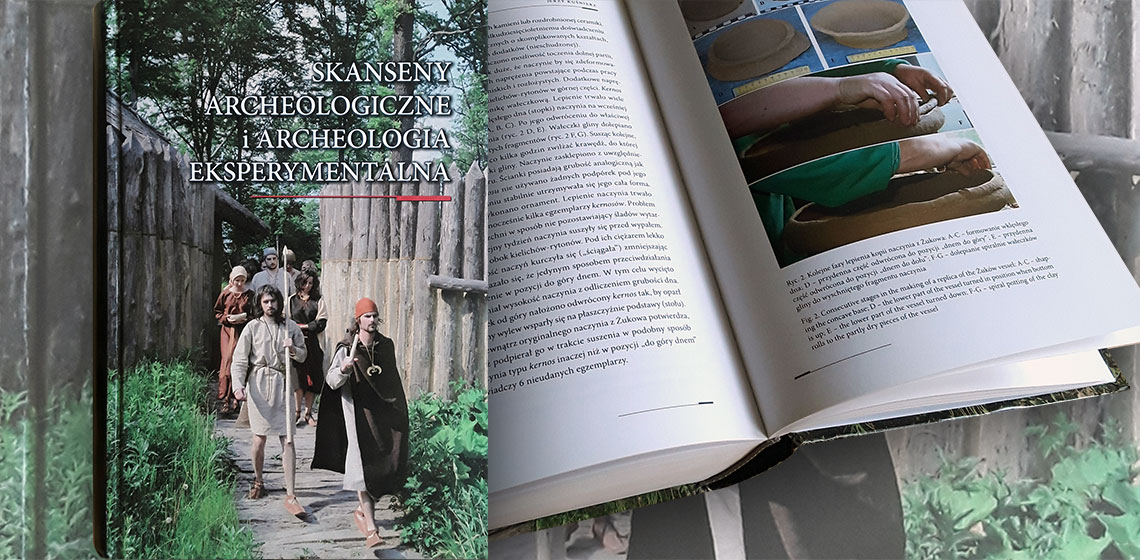
The book Skanseny Archeologiczne i Archeologia Eksperymentalna published by the Podkarpackie Muzeum in 2012 brings up the subject of open-air museums, opportunities and disadvantages of the promotion of cultural tourism and experimental archaeology mainly in Poland but also in Slovakia. Articles presented in this book were prepared for two different conferences organised by this museum.
The book was created as a response to growing interest in archaeology, reconstructive archaeology and cultural tourism. In the last few years, a big change started in Polish museums – from static, to narrative and interactive displays. New types of museum were invented and new way of thinking about museum exhibitions was created.
The first article written by Roeland Paardekooper is very good introduction to the problem. What is an open-air museum, how does this type of museum developed over time and what different functions does it have. In his article "open–air archaeological museums serving as tourist attractions, methods of evaluation and management", Zygmunt Kruczek shows different ways of measuring the quality of service, level of attractiveness of the site and typology of tourist attractions. The article shows how important such studies are and what measuring methods open-air museums can use. Having this as a starting position, it is a pleasure to read about different strategies and ideas for open-air museums.
The author of an extremely interesting and important article about Krzemionki Opatowskie, Marek Zalewski, points out that if open-air museums are to be a successful touristic product, three main elements need to be found there. These are a charismatic and strong leader, good foundations, and the support of local authorities. The conception of a new extension of the museum in Krzemionki Opatowskie might help with the popularisation of local tourism heritage. This publication is full of different case studies on this subject, displaying the ideas and projects of open-air museums from Poland and few from Slovakia.
A brilliant article "The Nowa Słupia centre for experimental archaeology and its project on man and iron in the first centuries AD: an opportunity for the development of archaeo-tourism in Kielce Region" written by Andrzej Przychodni smoothly connects the subject of open-air museums and cultural tourism with experimental archaeology and its role in education.
The author ponders about a good balance between genuinely scientific experiments, leisure activities, and education. To begin with, The Dymarki Festival, held since 1967, was introduced to local society as an archaeological experiment, which quickly developed into a big public event and recognisable touristic product. The main question is, what functions should such places like open-air museums have, especially when they are co-founded by municipalities. Is it right that local authorities use the infrastructure to organise, for example, rock concerts or other fairs and festivals not connected to main subject of the place? Is it possible to balance leisure activities with education and science? What is the best way to create dialog with local authorities? Other articles are trying to answer those questions.
The role of experimental archaeology students' associations and other historical and archaeological associations is strongly underlined in many of the articles in this book. The work of volunteers and students is crucial for most events. Experiments, which are taking place while archaeological fairs and meetings are open to the public, create a special atmosphere between scientists and tourists. In conclusion, it seems that even complicated scientific experiments might be very interesting for people. At the same time, it is very hard for scientists to concentrate on the subject and lead an experiment properly. This problem might be reduced by including a larger number of staff and volunteers facilitating the experiment.
There are a number of articles about concrete archaeological experiments about Stone Age archery, flint knapping and stone drilling, amber processing, ceramic making and firing etc. Popularisation of archaeology is needed and these open-air museums might be successful. The book shows that archaeology is a very interesting subject for the public. It might create real touristic products, become important for education and create totally new experiences for people. There are also various threads to popularise, from which the most important are: destroying archaeological sites whilst organising these festivals, creating a false or wrong view of the past, and creating copies not from primary sources but from secondary sources, references et cetera.
Publication contains various articles in Polish and Slovak, with English summary. All descriptions under pictures are both in Polish and in English. The book is full of colourful illustrations and pictures, which make it more interesting. Unfortunately, the summaries for most of articles are very short and do not explain even small parts of articles, which makes the articles difficult to understand for English readers. Despite of that it is very interesting and should hold an important position on a bookshelf for every archaeologist and archaeo-manager.
Book information:
GANCARSKI, Jan, ed. 2012. Skanseny Archeologiczne i Archeologia Eksperymentalna, Krosno: Muzeum Podkarpackie w Krośnie
ISBN 978-83-930273-3-0. 664 pages